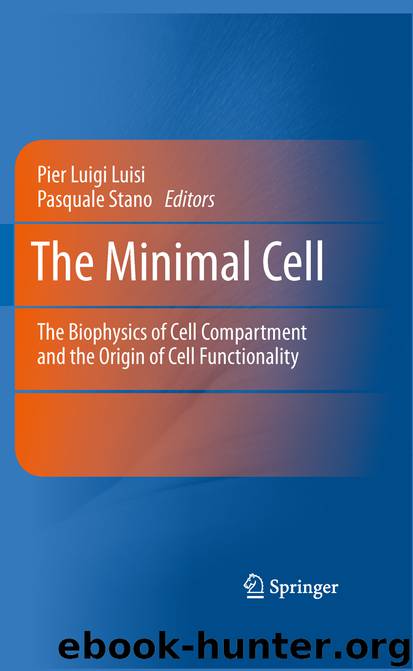The Minimal Cell by Pier Luigi Luisi & Pasquale Stano

Author:Pier Luigi Luisi & Pasquale Stano
Language: eng
Format: epub
Publisher: Springer Netherlands, Dordrecht
8.11 Conclusions and Future Directions
The study of carbonaceous meteoritic material and laboratory models of plausible Fischer-Tropsch type reactions show that vesicle-forming amphiphiles were likely to be present on the early Earth, and therefore could have participated in the formation of boundary membranes required by early cellular life. Moreover, short-chain amphiphile-based vesicles have properties similar to those of liposomes formed from phospholipids that are primary components of contemporary cellular membranes. They tend to be less stable and more permeable to ionic solutes, but as discussed here, higher permeability can be an advantage in the absence of specialized transport proteins.
Recent investigations have established that encapsulation procedures such as dehydration/rehydration or pH vesiculation permit simultaneous trapping of all components of complex catalytic systems, which remain active in the vesicular compartment. Furthermore, the membrane boundaries of such vesicles can protect the encapsulated catalysts from agents such as proteases and nucleases. On the early Earth, it seems likely that a membrane-protected microenvironment would be conducive to survival of spontaneous molecular systems on the evolutionary path to the first forms of life.
Another interesting aspect of amphiphile vesicles is their selective permeability, which permits the passive diffusion of smaller substrate molecules and prevents the release of larger metabolic products, thereby leading to accumulation of polymeric products. This observation demonstrates that an early form of life could have relied on a similar mechanism to take up nutrients and energy from the environment. The fact that enzymes having high turnover rates can be supplied with substrate by this simple mechanism supports the idea that a rather complex, perhaps ribozyme-based metabolism could be sustained in a closed compartment without need for transmembrane protein carrier systems. We also note that accumulation of polymeric products would permit and promote additional reactions that lead to increased metabolic complexity in cellular compartments.
Experiments have also demonstrated that simple vesicles composed of fatty acids could have undergone membrane growth using external amphiphile precursors, and thus undergo a kind of self-reproduction, in the sense that new vesicles are produced by growth and dispersion of preformed vesicles. This concept has been discussed in detail as a lipid world scenario (Segre et al. 2001).
However, the vesicle-based model systems described here also demonstrate the limitations of membrane-encapsulated reactions that must be overcome before we can design a model system endowed with the properties of a minimal cell (see Fig. 8.8). Even though single-component vesicles are useful laboratory models, they may not accurately reflect the compartment boundaries of early protocells in terms of mixed lipid components, permeability and substrate transport. When we attempt to model a protocell using highly evolved polymerase enzymes with high turnover rates, the low permeability of model bilayer membranes imposes significant limitations on successful outcomes. Recent studies tend to emphasize one aspect of a protocell, such as RNA polymerization, and lack the interacting metabolic pathways characteristic of living systems. Amphiphile vesicular systems with entrapped catalytic species possess no feedback regulation, a hallmark of life. Even though early cells may have incorporated simplified metabolic pathways, it would still
Download
This site does not store any files on its server. We only index and link to content provided by other sites. Please contact the content providers to delete copyright contents if any and email us, we'll remove relevant links or contents immediately.
Whiskies Galore by Ian Buxton(41532)
Introduction to Aircraft Design (Cambridge Aerospace Series) by John P. Fielding(32890)
Small Unmanned Fixed-wing Aircraft Design by Andrew J. Keane Andras Sobester James P. Scanlan & András Sóbester & James P. Scanlan(32574)
Aircraft Design of WWII: A Sketchbook by Lockheed Aircraft Corporation(32137)
Craft Beer for the Homebrewer by Michael Agnew(17934)
Turbulence by E. J. Noyes(7701)
The Complete Stick Figure Physics Tutorials by Allen Sarah(7143)
The Institute by Stephen King(6803)
Kaplan MCAT General Chemistry Review by Kaplan(6597)
The Thirst by Nesbo Jo(6439)
Bad Blood by John Carreyrou(6277)
Modelling of Convective Heat and Mass Transfer in Rotating Flows by Igor V. Shevchuk(6225)
Learning SQL by Alan Beaulieu(6037)
Weapons of Math Destruction by Cathy O'Neil(5831)
Man-made Catastrophes and Risk Information Concealment by Dmitry Chernov & Didier Sornette(5650)
Permanent Record by Edward Snowden(5540)
Digital Minimalism by Cal Newport;(5391)
Life 3.0: Being Human in the Age of Artificial Intelligence by Tegmark Max(5187)
iGen by Jean M. Twenge(5163)
